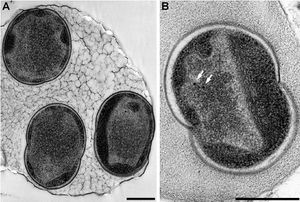Chromatium: Difference between revisions
| Line 14: | Line 14: | ||
[[File:alcanivorax bork.jpg|300px|thumb|right|Alcanivorax borkumensis [1F] ]] | [[File:alcanivorax bork.jpg|300px|thumb|right|Alcanivorax borkumensis [1F] ]] | ||
Chromatium is a gram negative bacteria found in marine environments. They tend to be straight rod shaped or even slightly curved rods. These bacteria belong to the purple photosynthetic sulfur bacteria that oxidize sulfide into sulfur which is deposited in intracellular granules in their cytoplasm | Chromatium is a gram negative bacteria found in marine environments. They tend to be straight rod shaped or even slightly curved rods. These bacteria belong to the purple photosynthetic sulfur bacteria that oxidize sulfide into sulfur which is deposited in intracellular granules in their cytoplasm. | ||
=Ecology and Significance= | =Ecology and Significance= | ||
Revision as of 18:47, 11 May 2015
Classification
Domain: Bacteria Phylum: Proteobacteria Class: Gammaproteobacteria Order: Chromatiales Family: Chromatiaceae Genus: Chromatium Species: Chromatium okenii
Description
Chromatium is a gram negative bacteria found in marine environments. They tend to be straight rod shaped or even slightly curved rods. These bacteria belong to the purple photosynthetic sulfur bacteria that oxidize sulfide into sulfur which is deposited in intracellular granules in their cytoplasm.
Ecology and Significance
Genome Structure
Metabolism
References
[1] Golyshin, Peter N. “Genome Sequence Completed of Alcanivorax borkumensis, a Hydrocarbon-degrading Bacterium That Plays a Global Role in Oil Removal from Marine Systems.” 3 (2003): 215-20. Print.
Neyra, Carlos A. Carbon Metabolism. Boca Raton, FL: CRC Pr., 1985. Web. 11 May 2015.
Figures
[1F]
[1] [2F] [2] [3F] [3] [4F] [4] [5F] [Original Figure. Author: Pawan Dhaliwal] [6F]
http://microbewiki.kenyon.edu/index.php/File:Lorenzo.gif
[7F] [5]
Author
Page authored by Sukhwinder Kaur, student of Prof. Katherine Mcmahon at University of Wisconsin - Madison.

